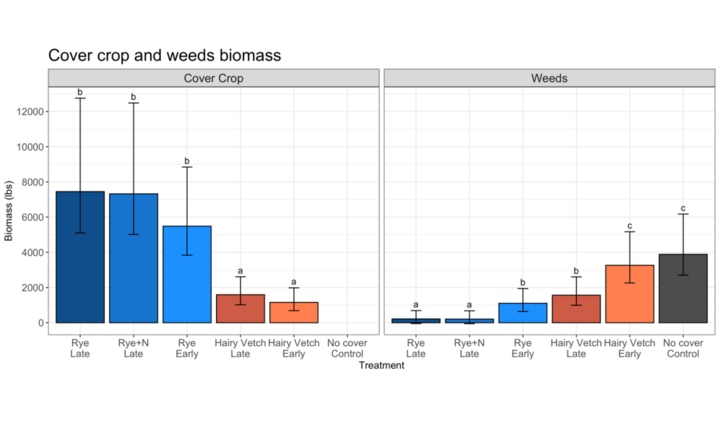How can we best manage cover crop termination time to suppress weeds and increase corn yield?
Winter cover crops compete with weeds for water, nutrients and sunlight in the fall and spring. This competition for resources is understood to impact the efficacy of weed suppression when cash crops, such as corn or soybean, are planted in the spring.
Terminating the cover crop closer to cash crop planting will allow more time for cover crop growth when compared to cover crops terminated several weeks earlier. However, there are limited research trials on the impact of later terminated cover crops on cash crop yield, even though many producers are experimenting with this management, sometimes referred to as “planting green”. Providing the cover crop with additional growing season later in the spring can provide more biomass for weed suppression, and possibly make up for later cover crop planting in the fall.
Understanding this management system is important for producers looking for options to optimize cover crop growth, benefit, and possibly the reduction of costs or amount of herbicides applied to their cash crops.
Field Management
In this study, we are evaluating the impact of two cover crop species (cereal rye and hairy vetch), and two termination times (early — 10 days before planting corn; late — seven days after planting corn) on weed suppression and corn yield. This experiment will be replicated three years, and the first year of the experiment was conducted in the 2020-2021 season at the Eastern Nebraska Research, Extension and Education Center (ENREC), near Mead, Nebraska. The experimental design included the following treatments and management history.
| Treatments | Cover Crop Planting | Cover Crop Sampling | Cover Crop Termination |
|---|---|---|---|
| No cover crop check | - | - | - |
| Cereal rye terminated early | 10/1/20 | 4/27/21 | 4/29/21 |
| Cereal rye terminated late | 10/1/20 | 5/20/21 | 5/21/21 |
| Cereal rye terminated late + 50 lbs. N pre-plant | 10/1/20 | 5/20/21 | 5/21/21 |
| Hairy vetch terminated early | 10/1/20 | 4/27/21 | 4/29/21 |
| Hairy vetch terminated late | 10/1/20 | 5/20/21 | 5/21/21 |
A quadrat of 0.25 m2 was used to sample the cover crop biomass and the biomass of weeds. Four subsamples were taken from each treatment. The corn was planted on May 13 at the V4 corn stage, and all the treatments received 150 lbs. of N acre, except for the treatment with an extra N rate which received 200 lbs. of N per acre. The weed biomass was sampled on the same day of cover crops, in the same quadrats. Samples were dried in an oven at 60°C for four days and then weighed.
Results from Year One
Cereal rye produced the most biomass, from 7,900 (late termination) to 5,700 lb/acre (early termination) whereas hairy vetch biomass ranged from 1,600 (late termination) and 1,160 lb/acre (early termination). The later cover crop termination did not significantly increase biomass in both species.

However, late termination of cereal rye resulted in the least amount of weeds, decreasing weed biomass by more than 94% compared to the no cover crop control. Compared to the no cover crop control, weed biomass was reduced by 72%, 60% and 16% by cereal rye terminated early, hairy vetch terminated late and hairy vetch terminated early, respectively.

The yield of corn following cereal rye terminated late decreased by 28% compared to the no cover crop control. The extra corn pre-plant N rate (extra 50 lb/acre) also led to a yield decrease of 15% compared to the no cover crop control. Corn yields following both termination times of hairy vetch and the early termination of cereal rye were statistically the same as the no cover crop control.
As a result, in year one we learned that the cereal rye terminated early, and hairy vetch terminated late show the combined benefits of suppressing weeds and sustaining corn yields relative to a no cover crop control.
This experiment will be repeated two more years, in 2022 and 2023. The results from the first year show the potential of two different species of cover crops — a grass and a legume — being effective in controlling weeds while sustaining corn yields relative to a control, depending on the cover crop species and termination timing.
Acknowledgements
This experiment is a part of the Precision Sustainable Agriculture (PSA), a collaborative project supported by the Agriculture and Food Research Initiative’s Sustainable Agricultural System Coordinated Agricultural projects from the United States Department of Agriculture (USDA). The authors would like to thank the Precision Sustainable Agriculture (PSA), and the Robert B. Daugherty Water for Food Global Institute (DWFI) for funding support, as well as Tom Galusha and Roy Cumming for their support with field research.

